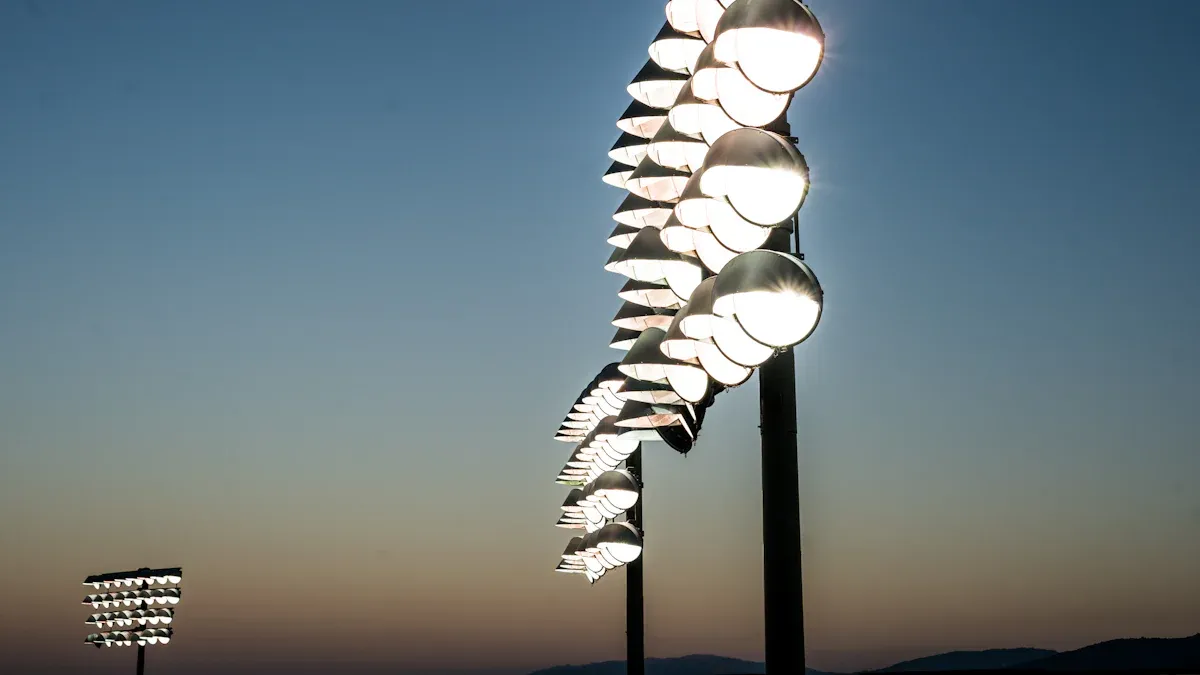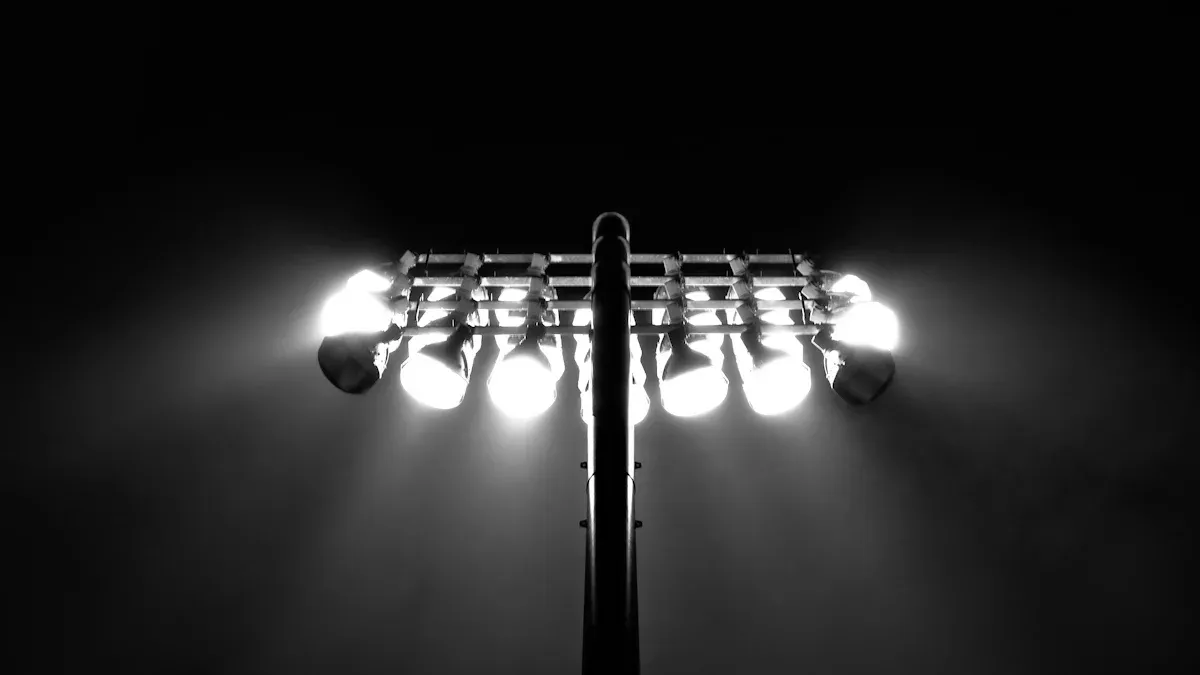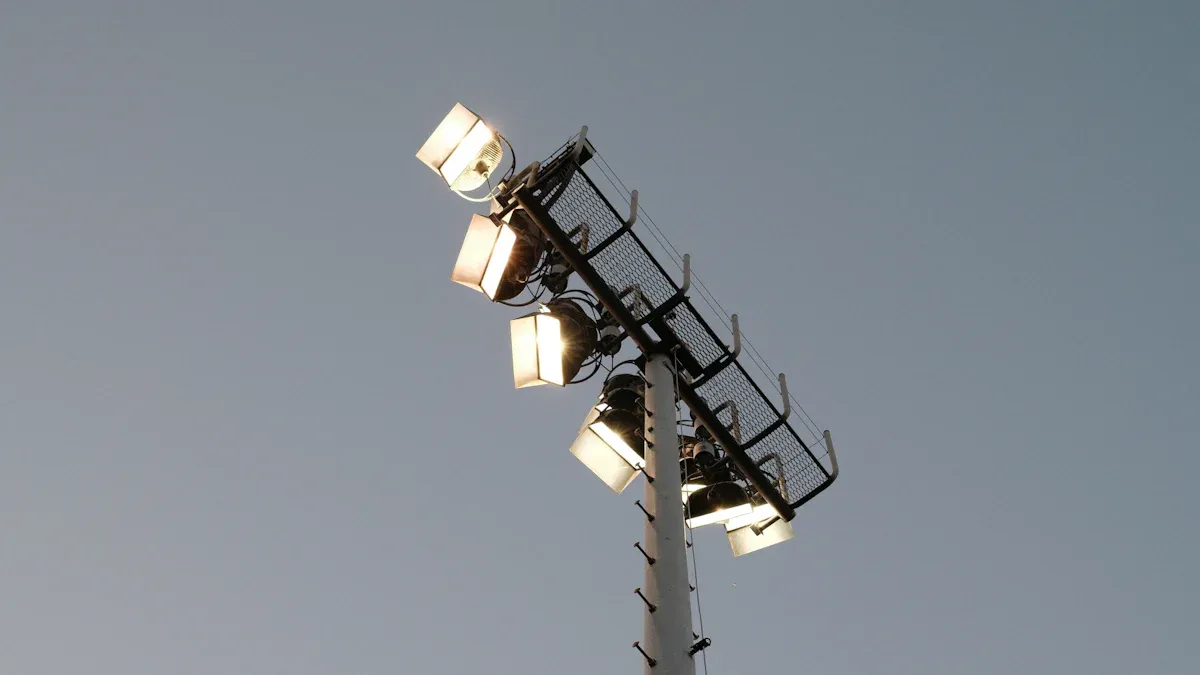LED Technology in Modern Flood Lights

Flood lights have changed a lot thanks to LED technology. This innovative product saves energy and lasts a long time. LED lights, specifically LED flood lights, use up to 90% less power than old bulbs, significantly lowering electricity bills. They can last over 100,000 hours, requiring little maintenance. These bright and clear lights enhance safety in outdoor areas. By 2030, they could help cut CO₂ emissions by 550 million tons. LED flood lights are not just lights—they also contribute to protecting the planet, especially when combined with solar light options.
Key Takeaways
LED flood lights use much less energy than old bulbs.
They can last over 50,000 hours, so need fewer changes.
These lights are bright and don’t cause glare, making areas safer.
Using LED flood lights lowers CO₂ and helps the environment.
Features like motion sensors and brightness control make them useful.
Understanding LED Technology in Flood Lights
The science behind LED technology
LED technology has completely changed how we light up spaces today. An LED is a tiny device that lights up when electricity passes through it. This process, called electroluminescence, happens when energy turns into light. Unlike old bulbs with filaments or gas, LEDs make light directly from electricity. This makes them much more efficient.
One big reason LED flood lights are special is their energy-saving ability. They use most of the electricity to make light, wasting very little. This makes them a great choice for the environment. Also, LEDs turn on instantly without needing time to warm up. This is helpful for security lighting. They are tough and can handle shocks and vibrations, so they work well in rough conditions.
Component | What It Does |
|---|---|
LED Diodes | Tiny parts that light up when electricity flows through them. |
Driver Circuit | Controls the power to keep the LEDs working properly. |
Heat Sink | Keeps the LEDs cool by getting rid of extra heat. |
Optics and Reflectors | Direct the light to shine exactly where it’s needed. |
Energy Efficiency | Uses electricity wisely, turning most of it into light. |
Longevity | Lasts a long time, often over 50,000 hours. |
Instant Illumination | Lights up right away, which is great for safety lighting. |
Customizable Lighting | Lets you adjust the light to fit your needs. |
Durability | Strong enough to handle tough environments and impacts. |
Key components of LED flood lights
The quality of LED flood lights depends on their parts. These parts work together to create bright, long-lasting light.
Durability and IP Ratings: These lights are built to handle tough weather. For example, IP65 keeps out dust and water sprays, while IP67 can handle being underwater for a short time.
Materials Used: Aluminum helps get rid of heat and prevents rust. Strong glass protects the light from damage.
Energy Efficiency: They use less electricity, saving money on power bills.
Lifespan: They last 30,000 to 50,000 hours, so you don’t replace them often.
Heat Management: Special systems stop them from overheating, keeping them reliable.
Quality Components: Good materials make these lights dependable for many uses.
These features make LED flood lights a top choice for outdoor and industrial lighting.
How LED flood lights achieve superior illumination
LED flood lights shine brightly and evenly, using less power than older lights. They save energy and lower electricity costs while being just as bright or brighter. This also helps reduce pollution.
You can customize LED flood lights to fit your needs. Aim the light where you want, change colors, or add motion sensors for extra features. They give clear, glare-free light, making outdoor areas safer. Their flexibility makes them perfect for homes, businesses, and factories.
LED flood lights are also good for the planet. They don’t have harmful materials like mercury. Choosing LEDs means better lighting and helping the environment at the same time.
Advantages of LED Flood Lights

Energy efficiency and cost-effectiveness
LED flood lights save energy and lower electricity costs. They use up to 90% less power than old-style bulbs. This makes them one of the best energy-saving lights today. Businesses and outdoor spaces can save a lot on bills. For instance, LED high bay lights cut energy use by half, reducing expenses.
These lights also lower maintenance costs. LEDs can last up to 50,000 hours, so you replace them less often. Unlike older bulbs, LEDs don’t burn out suddenly. Instead, they slowly get dimmer, giving steady light over time. This makes them perfect for places like parking lots or warehouses needing constant light.
Better lighting can also improve work performance. Studies show brighter lights can make workers 20% more productive. Choosing LED flood lights means saving money and improving how people work.
Longevity and minimal maintenance
LED flood lights last a very long time. They often work for over 50,000 hours, much longer than regular bulbs. This means fewer replacements, saving both time and money. While factors like use and weather can affect lifespan, LEDs still perform well in tough conditions.
Unlike old bulbs that stop working suddenly, LEDs dim slowly. This gives you time to plan replacements without losing good lighting. Standards like LM-80 and TM-21 check how long LEDs will last. These tests ensure LEDs are reliable for long-term use.
LEDs need little upkeep. They are strong and can handle shocks, vibrations, and bad weather. This makes them great for outdoor and industrial areas. By using LED flood lights, you avoid frequent repairs and enjoy dependable lighting.
Enhanced brightness and color accuracy
LED flood lights are very bright and show colors clearly. Their advanced design gives even, glare-free light, making outdoor spaces safer. Whether lighting a yard, stadium, or factory, LEDs provide strong, steady light.
They also show colors accurately. Tools like the Color Rendering Index (CRI) measure how well LEDs display colors. High CRI values mean colors look real and vibrant under LED lights. This is important for photography, videos, or store displays.
Metric | What It Means |
|---|---|
CRI | Shows how well colors look under the light. |
TLCI | Rates light quality for videos. |
CQS | Checks how humans see color quality. |
Tools | Devices like spectrometers measure light quality. |
LED flood lights can be customized. You can change brightness, pick colors, or add motion sensors. This makes them useful for homes, events, or businesses. Choosing LEDs gives you lights that are efficient, durable, and precise.
Environmental benefits of LED flood lights
Switching to LED flood lights helps the environment in many ways. These lights use less energy, create less waste, and are safer for the planet. Choosing LEDs supports a cleaner and greener world.
A big advantage of LED flood lights is saving energy. Old lights waste electricity, but LEDs use it wisely. They need less power to shine just as brightly. For example, replacing street and airport lights with LEDs greatly cuts energy use. This lowers electricity costs and reduces the need for fossil fuels. Using less fossil fuel helps decrease greenhouse gases.
LED flood lights also reduce light pollution. Unlike older lights, LEDs can focus light exactly where it’s needed. This prevents extra light from spilling into areas it shouldn’t. Too much light can harm animals and block views of the night sky. A study in Tucson, Arizona, used satellite images to compare LEDs and old lights. It showed that LED street lights caused less sky glow, keeping the night darker.
Evidence Type | Description |
|---|---|
Light Pollution Impact | LED street lights reduce sky glow more than older lights. |
Energy Consumption | Switching to LEDs lowers energy use in many places. |
Research Methodology | Satellite images studied how LEDs and old lights affect the sky. |
Another benefit of LED flood lights is their long life. They last much longer than regular bulbs, so you replace them less often. Fewer replacements mean less trash and less harm from making and throwing away old bulbs.
LEDs are also free of harmful materials like mercury, which is found in some old bulbs. Using LEDs avoids releasing toxic substances into the environment. This makes them safer for people and nature.
By using LED flood lights, you help protect the planet. Their energy savings, reduced light pollution, and eco-friendly design make them a smart choice for a better future.
Comparing LED Flood Lights with Traditional Lighting
LED vs. halogen flood lights
LED flood lights are much better than halogen ones. LEDs last over 50,000 hours, while halogens burn out fast. This means fewer replacements and lower costs for LEDs. They also use less energy, saving money on electricity bills. Halogen lights need more power for the same brightness, which costs more.
LEDs are also safer for the environment. They don’t have harmful materials and are easier to recycle. Halogen lights can harm the planet because of their materials. LEDs stay cooler, making them safer to touch and use. The table below shows these differences:
Metric | LED Flood Lights | Halogen Lighting Systems |
|---|---|---|
Lifespan | Over 50,000 hours | Shorter lifespan |
Energy Efficiency | Uses less energy | Needs more energy |
Environmental Impact | Eco-friendly, recyclable | Contains harmful materials |
Cost Considerations | Costs more upfront, saves later | Cheaper upfront, costs more later |
Brightness | Dimmable, bright with less power | Needs more power for brightness |
Surface Temperature | Cooler than halogen | Gets much hotter |
LED vs. incandescent and metal halide flood lights
LEDs are better than incandescent and metal halide lights too. Incandescent bulbs waste energy by turning it into heat. Metal halide lights are bright but take time to warm up. LEDs turn on instantly and stay bright for a long time.
LEDs are also stronger and last longer. They can handle shocks and vibrations, making them great for outdoor use. Incandescent and metal halide lights are fragile and break easily. LEDs can also be adjusted for brightness and color. This makes them useful for homes, events, and businesses.
Why LED flood lights are the preferred choice
LED flood lights are now the top choice for lighting. They save energy, last long, and shine brightly. In 2022, the LED flood light market was worth $5.3 billion. It’s expected to grow by 14.5% each year from 2023 to 2030. This growth is due to the need for energy-saving lights and eco-friendly policies.
LEDs are used in homes, businesses, and factories. They’re also popular for outdoor lighting and big projects. Choosing LEDs saves money and helps the planet. They are a smart and green choice for the future.
Key Applications of LED Flood Lights

Outdoor lighting for security and landscaping
LED flood lights are important for outdoor lighting. They help with security and landscaping. These lights brighten dark areas, making it easier to see threats. They also scare away intruders. LED flood lights are 5-7 times brighter per watt than halogen lights. They use 85% less energy, saving money and helping the environment.
Outdoor spaces have become more popular since 2020, growing by 78%. This has increased the need for good lighting. LED flood lights last up to 57,000 hours, or about 13 years of evening use. Their long life means fewer replacements and less maintenance.
LED flood lights make gardens and buildings look better.
They aim light carefully, reducing extra light and keeping outdoor areas natural.
Tests show modern LED flood lights are 87% more energy-efficient than older ones.
Industrial and commercial lighting solutions
LED flood lights are great for factories and warehouses. They are strong and work well in tough conditions. These lights stay bright and use less energy, cutting costs for businesses.
Many industries now use LED flood lights because they save energy and last long. They also work with smart systems for better control and efficiency.
In July 2023, Chicago replaced 280,000 streetlights with smart LED lights. This cut energy use by 50%. This shows how LED lights help cities save money and energy. In 2023, commercial buildings used LED flood lights the most. Construction and healthcare also increased their use. Industrial areas are expected to grow as they need durable and reliable lighting.
Sports arenas and large-scale event lighting
LED flood lights are perfect for sports and big events. They give bright, clear light and save energy. These lights make it easy to see and enjoy games or performances.
LED sports lights have a CRI of 85+, better than HID lights with 70+.
They produce 100-150 lumens per watt, while HID lights only reach 100 LPW.
Metric | Description |
|---|---|
Lumen Output | Shows how much visible light the fixture gives off. |
Color Rendering Index (CRI) | Measures how well colors look under the light; higher numbers are better. |
Lumens per Watt (LPW) | Rates how efficient the light is; higher numbers mean better energy use. |
LED flood lights shine evenly and reduce glare. This keeps players and fans safe. Their energy-saving design lowers costs, making them a top choice for stadiums and events.
Innovations in LED Flood Light Technology
Smart lighting systems and IoT integration
Smart lighting has changed how we use LED flood lights. With IoT, you can control lights from anywhere. Adjust brightness or set schedules easily. This helps save energy by using lights only when needed.
These systems also work with other technologies like HVAC and security. For example, lights can change based on movement or room use. This makes managing homes, businesses, and factories simpler. It saves energy and improves efficiency.
Feature/Benefit | What It Does |
|---|---|
Remote Monitoring | Lets you control lights from far away. |
Helps save power and lower electricity bills. | |
System Integration | Connects with HVAC and security for better management. |
Adaptive brightness and motion-sensing technology
Adaptive brightness makes LED flood lights smarter. Lights get brighter in dark areas or dim when there’s enough light. This saves energy while keeping spaces well-lit.
Motion sensors make lights turn on only when movement is detected. This adds safety and avoids wasting power. These features are great for parking lots and pathways. Together, they make lighting efficient and reliable.
Emerging trends in LED flood lighting
LED flood lights are improving with new trends. They use less energy, helping the planet and saving money. Bright lights are popular for sports and outdoor events. People also want lights they can adjust to fit their needs.
Better designs, like improved optics, make lights last longer. Online shopping makes it easy to buy these products. New rules about energy use encourage people to switch to LEDs.
Smart Lighting: Control lights remotely and save energy.
Eco-Friendly: Uses less power, good for the environment.
High-Performance: Great for parks and sports fields.
Adjustable Features: Change brightness to match your needs.
Advanced Technology: Better optics and cooling systems.
Online Shopping: Easier to find and buy LED lights.
Energy Rules: Push for eco-friendly lighting options.
Innovation Type | What It Offers |
|---|---|
Brightness | Produces strong light, almost like daylight. |
Energy Efficiency | Uses less power but stays bright. |
Durability | Handles bad weather and lasts longer. |
Smart Features | Includes remote control and automatic adjustments. |
LED flood lights are great for today’s lighting needs. They use up to 80% less energy than older lights, cutting electricity costs. These lights last over 50,000 hours, so you replace them less often. This long life saves money and creates less waste, helping the planet.
Benefit | Fact |
|---|---|
Energy Use | Uses 80% less power |
Lifespan | Works for more than 50,000 hours |
Money Savings | Costs less over time |
Eco-Friendly | Lowers greenhouse gas emissions |
Switching to LED flood lights means saving money and helping the Earth. Start using them now for brighter, eco-friendly lighting!
FAQ
Why are LED flood lights good for outdoor security?
LED flood lights shine brightly, lighting up dark spaces clearly. They last long and are tough, making them dependable. Motion sensors can spot movement, adding extra safety to your home.
How do LED flood lights help in big areas?
LED flood lights give steady, glare-free light over large spaces. They are very bright and show colors well, making them great for stadiums, parking lots, and factories.
Are LED flood lights better for the environment?
Yes, LED flood lights use less power and last longer than old bulbs. They create less waste and don’t have harmful stuff like mercury. Their energy-saving design helps cut greenhouse gases.
Can you adjust LED flood lights for different uses?
Yes, you can change how bright they are or their color. You can also adjust the light’s direction and add motion sensors. These features make them useful for many purposes.
How do LED flood lights make public spaces safer?
LED flood lights brighten public areas, keeping intruders away and improving safety. They turn on quickly and cover wide spaces, helping people feel safe in parks, paths, and parking lots.
See Also
Exploring LED Street Lighting: Advantages and Modern Technology
Enhancing Road Safety with Efficient LED Highway Lighting
Understanding the Advantages and Tech of LED Street Lights
The Advantages of LED Street Bulbs: Efficiency and Longevity

